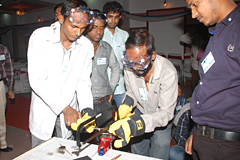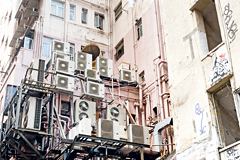'Keeping cool in India'

IKI project is promoting the production of sustainable air-conditioning systems in Asia
It is summer in India and temperatures in Mumbai are getting up into the unbearable zone. It is particularly hot in the city, where there are scarcely any trees to provide shade, which in turn means there is no natural cooling effect. In densely populated areas there is little air flow, the thermometer rises to over 35 degrees and people groan as the heat starts to get to them.
The Chaudhari family is no exception. Over lunch, Ms Chaudhari explains that she has decided to buy an air-conditioning system. She admits that it will mean spending more on electricity, but says the ceiling fan is just not doing enough to create a comfortable room temperature. Her daughter adds she finds it hard to concentrate on her homework because the heat in the house is so unbearable. The Chaudhari family belongs to the middle class and therefore to a sector of the population that increasingly takes owning an air conditioner for granted. Around four million air conditioners are now purchased each year in India.
It is a similar picture in other up-and-coming emerging economies in Asia. Whether in Jakarta, Bangkok, Mumbai or Manila, air-conditioning systems are becoming increasingly widespread and even in sweltering heat the temperature in office buildings, shopping malls and homes is a pleasant 20 degrees Celsius. Air-conditioned buildings are not only a sign of growing prosperity, they are also promoting the development of a modern economy in these countries. The booming service industry in cities such as Hong Kong or Singapore has only been able to take off as a result of the arrival of air-conditioning systems, because a room temperature of more than 25 degrees Celsius causes fatigue and compromises productivity. A survey in Singapore revealed that a temperature of 22 degrees Celsius is perceived as neutral - i.e. neither hot nor cold - but outdoor temperatures there can range between 22 and 35 degrees Celsius.
Although air conditioning can improve wellbeing in tropical temperatures, it also puts pressure on the power grids, especially in countries that have an unstable electricity supply. Cooling systems are very energy-intensive and in developing countries often run on fossil fuels, thus contributing to greenhouse gas emissions.
These indirect emissions are not the only negative impact that air-conditioning systems have on the climate. They also produce direct emissions in the form of refrigerants escaping from appliances; they are highly damaging to the climate, since they belong to the group of halogenated or fluorinated hydrocarbons.
Synthetic refrigerants: a threat to the climate and the ozone layer
 Halogenated and fluorinated gases are synthetically produced and used primarily as refrigerants in appliances such as refrigerators and air-conditioning systems. Since some of these gases are highly ozone-depleting, the international community agreed in the 1987 Montreal Protocol to introduce a worldwide ban on chlorofluorocarbons (CFCs) and a gradual phase-down of partially halogenated hydrochlorofluorocarbons (HCFCs).
Halogenated and fluorinated gases are synthetically produced and used primarily as refrigerants in appliances such as refrigerators and air-conditioning systems. Since some of these gases are highly ozone-depleting, the international community agreed in the 1987 Montreal Protocol to introduce a worldwide ban on chlorofluorocarbons (CFCs) and a gradual phase-down of partially halogenated hydrochlorofluorocarbons (HCFCs).
The Montreal Protocol is an effective environmental agreement and the first examples of success in protecting the ozone layer, which was the stated aim of the agreement, are already quantifiable. Since then, industry has completely ceased to produce CFCs and is increasingly phasing out HCFCs. The most common alternative refrigerants are partially halogenated fluorocarbons (HFCs), which are ozone-neutral and therefore not regulated by the Montreal Protocol.
However, HFCs are extremely damaging to the climate. For example, the global warming potential of the refrigerant R404a is 3,900 times higher than that of carbon dioxide. This devastating impact is further exacerbated by the fact that demand for cooling is growing rapidly, especially in developing countries and emerging economies, where the use of synthetic refrigerants is particularly widespread. There has been massive growth of the middle classes in China, India, Indonesia and Thailand as a result of their booming economies. Belonging to the middle class means being able to afford to live in pleasant temperatures. Air conditioners are therefore one of the first things households purchase when their income rises.
Another reason for the increasing use of air conditioning is the rise in average temperatures and more frequent hot spells we are witnessing as climate change begins to kick in. In particular, sales of what are known as split air conditioners, which have an indoor and outdoor unit, are rising because they are comfortably suitable for retrofitting existing buildings. Manufacturers have responded to this development by expanding their sales structures in the relevant countries.
Against this backdrop, it is obvious that more and more climate-damaging gases are being released into the atmosphere. By 2030 they could be responsible for up to 13.1 % of global warming - an alarming prognosis. In India, sales of cooling systems also have huge growth potential. To date roughly 40 per cent of the systems in use are to be found in the cities, whereas market share in the entire country is currently only three to four per cent. More and more appliances are being purchased in urban regions and the industry's growth rate is 13.5 per cent.
Air-conditioning systems and other technologies in the cooling sector, such as refrigerators with synthetic refrigerants, are thus a major factor in the country's greenhouse gas emissions. At the same time, this industry has vast reduction potential. Natural refrigerants such as ammonia, hydrocarbons and carbon dioxide are climate-neutral alternatives to HFCs. Their use in cooling appliances also improves energy efficiency. Although this option is technically mature, it is scarcely used outside Europe at present. To date the opportunities for saving energy and reducing greenhouse gases by using natural refrigerants in the cooling sector are not sufficiently well known internationally.
IKI promotes the production of sustainable air-conditioning systems in India
 In 2012, the Indian manufacturer Godrej & Boyce developed a range of air-conditioning systems that use the natural refrigerant propane. This family business received an investment grant for the production line from the German Environment Ministry's International Climate Initiative (IKI). The Deutsche Gesellschaft für Internationale Zusammenarbeit (GIZ) is the implementing organisation in charge of the project on the ground.
In 2012, the Indian manufacturer Godrej & Boyce developed a range of air-conditioning systems that use the natural refrigerant propane. This family business received an investment grant for the production line from the German Environment Ministry's International Climate Initiative (IKI). The Deutsche Gesellschaft für Internationale Zusammenarbeit (GIZ) is the implementing organisation in charge of the project on the ground.
Propane is a natural refrigerant and thus does not contribute to climate warming, even if it does escape from an appliance. However, propane gas is flammable, which means that compliance with safety standards poses a particular challenge. Dilip Rajadhyaksha, an engineer with Godrej, explained: 'We use a very small amount in each appliance - just 350-370 grams. Even if all of that were to leak out there would still be no fire risk.'
Godrej's appliances have set completely new standards for climate protection and energy efficiency in India. The cuts in harmful greenhouse gases produced during the manufacturing, operation and disposal of an air-conditioning system are equal to the average amount of CO2 emitted annually by a car in Germany. The energy consumption of Godrej's appliances is on average 23 per cent lower than that of comparable appliances. Customers benefit directly from this and the low running costs are often the decisive argument for buying a Godrej appliance, as Liaba Deboo from the company's marketing department tells us.
Down at a small electrical store, the Chaudharis also choose a Godrej air conditioner. It costs about ten per cent more than conventional air conditioners, but the lower energy costs easily justify the higher purchase price. Once the purchase has been completed, two engineers install the appliance in the family's house in Mumbai. In a training course run by the manufacturer, they have learned how to handle flammable and how to stop the refrigerant from leaking during installation of the indoor and outdoor units.
Godrej already sold 100,000 appliances in the first two years after the market launch. Since each of these appliances cuts climate relevant emissions, the International Climate Initiative project makes a huge contribution to mitigating climate change. The company's economic success also sends a message to other manufacturers and stimulates the expansion of sustainable technologies in India's cooling sector.
International Climate Initiative projects are also supporting companies in other Asian countries to switch their cooling system production to environmentally sound alternatives. In 2011, for example, a similar project worked with Chinese manufacturer Gree to set up a production line for air-conditioning systems using natural refrigerants. China is the world's leading manufacturer of split air conditioners, producing around 90 per cent of all appliances of this type. Consequently, Chinese developments in this field will have a worldwide impact.
A number of South-East Asian countries are currently considering developing nationally appropriate mitigation actions (NAMAs) in the cooling sector with the support of the International Climate Initiative and the Deutsche Gesellschaft für Internationale Zusammenarbeit. NAMAs are tools for tackling climate change, which emerging economies incorporate into their national development plans with international support. This would enable them to modernise their cooling sector and, by using more environmentally sound energy, become more competitive and help to protect the climate and to become more competitive, while also harnessing vast potential for savings in energy consumption. This produces synergies between international climate change mitigation and sustainable development policies in Asia's emerging economies. In a global project, the International Climate Initiative is also promoting the development of instruments and methods for producing a NAMA in the cooling sector. Part of the project's work is to develop NAMAs for selected sectors in close cooperation with the partner countries and the various stakeholders.
The International Climate Initiative also funds the Green Cooling Initiative, which brings worldwide 'cooling experts' together and instigates an exchange of experience acquired in the course of IKI projects to date in the field of sustainable cooling technologies. The Green Cooling website (external) is a platform for this exchange and also contains extensive information on sustainable technologies in the cooling sector, along with country-specific emission data that can be downloaded.
The link has been copied to the clipboard
Contact
IKI Office
Zukunft – Umwelt – Gesellschaft (ZUG) gGmbH
Stresemannstraße 69-71
10963 Berlin
Related Videos
Related Publications
-
 05/ 2022 | IKI Evaluation
05/ 2022 | IKI EvaluationGreen Cooling Initiative
German with executive summary in English (PDF, 2 MB, barrier-free)
















